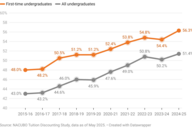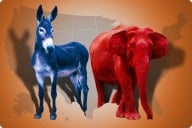You have /5 articles left.
Sign up for a free account or log in.
In September of 2000, the University of Wisconsin at Madison and the University of Idaho were both embarrassed when they were forced to admit that they had doctored promotional photographs to make their campuses look diverse. In both cases, non-white faces were added to real student photographs of all-white groups.
At the universities involved, officials insisted that they meant well, but just about everyone agreed that Photoshop diversity isn't the real thing. But what if photos, even real photos of real live students, convey a false impression?
A sociologist at Augsburg College, together with an undergraduate, recently studied the viewbooks of hundreds of four-year colleges and universities, selected at random. The research team counted the racially identifiable student photographs and also gathered data on the actual make-up of the student bodies.
The findings: Black students made up an average of 7.9 percent of students at the colleges studied, but 12.4 percent of those in viewbooks. Asian students are also more likely to be found in viewbooks than on campus, making up 3.3 percent of real students on average and 5.1 percent of portrayed students. The researchers acknowledge that appearance does not always tell the story of race and ethnicity, and say that they only counted clearly identifiable photos, and feel less confident about figures for Latino students. But they report relatively few students whose appearance suggested that they might be Latino, which is striking given the growth in the Latino student body. (A total of 371 colleges were studied, and historically black colleges were excluded; the findings were recently presented at the meeting of the Midwest Sociological Society.)
Looked at another way, he found that more than 75 percent of colleges appeared to overrepresent black students in viewbooks.
So why are black students more prevalent in viewbooks than on campus?
"Black equals diversity for many people. If you show African American students, people think that means your institution is diverse," said Timothy D. Pippert, an assistant professor of sociology at Augsburg, who led the study. "They are defining diversity as that face."
Pippert said that he didn't think colleges were acting "maliciously," and were primarily trying to send a positive message -- that "this is a place where you'd be welcome."
At the same time, he said he worried that the message seems to be focused primarily on one group and that those who are black may not be getting an accurate picture. "I see a problem in that so many schools are presenting a picture that may not be a valid representation," he said.
George Dehne, who runs an eponymous admissions consulting firm, said that it is unfortunate that colleges try to portray themselves as having more black students than they do, but he sees it all the time. "We tell colleges that it's a mistake and they shouldn't do it, but we get overruled," he said. "Sometimes you see the same black kid in every picture," he said.
Colleges are generally convinced that they need to show a lot of black students to recruit a lot of black students, he said. But Dehne said that logic is flawed. "First we don't recommend it because it's not honest," he said. But Dehne also questioned whether it really works -- at least for prospective students who visit a campus. "When kids come to campus, they look around for all those extra people and don't find them," he said.
A college without large minority enrollments that wants more diversity is better off portraying itself honestly and talking about why it will be a good place for given students, Dehne said. Along those same lines, Dehne said some colleges have created brochures that focus on diversity issues -- but that he urges them not to send them out based on zip codes or last names or various clues as to likely ethnicity, but to send only general materials unless a student asks for more information. Surveys of students suggest that they don't want assumptions made about them, he said. "If students want to be recognized [as minority], they want to do it on their own terms," Dehne said.
Of course, racial representation isn't the only selective editing that may be going on in viewbooks. Colleges' promotional materials somehow manage not to include many students who look like they just pulled an all-nighter -- and they tend to include more happy, attractive students than one might see on an average day. Pippert said his research didn't include questions of whether there was overall accuracy in the students portrayed, but noted that one student who helped in the research quipped that the photos were generally of "hot chicks and minorities."




